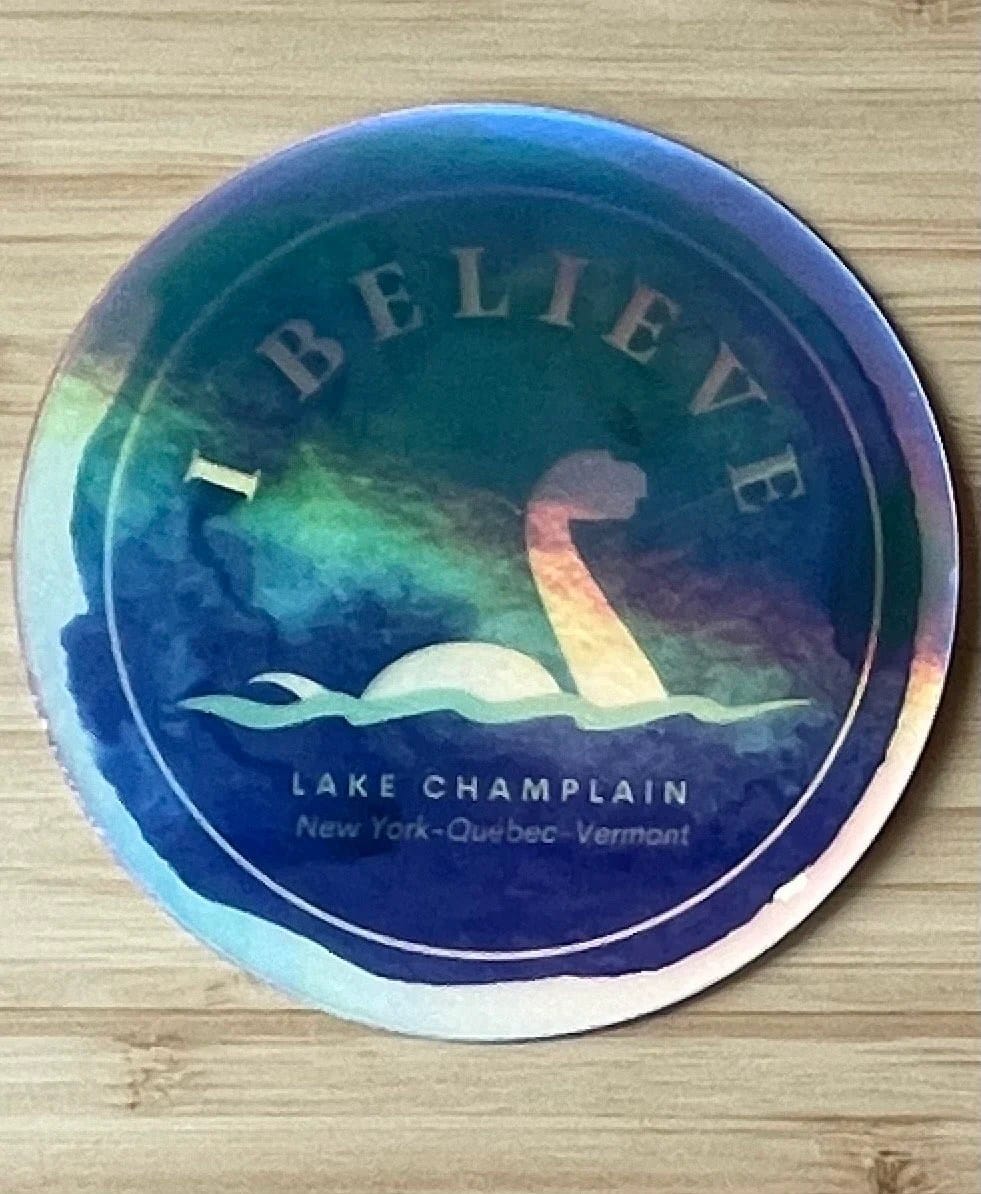Dive into the mystery surrounding Champ Lake Champlain and uncover the truth behind the legendary creature said to inhabit its depths.
Champy: A Legend Centuries in the Making
Lake Champlain, a sprawling 125-mile freshwater giant nestled between New York, Vermont, and a touch of Quebec, holds a secret – or so the stories say. For centuries, whispers have echoed around its shores, tales of a creature unlike any other: Champy, the elusive Lake Champlain Monster. But what is Champy? Is it a real cryptid, a relic of a bygone era, or simply a captivating tale woven from folklore and misidentification?
Indigenous Roots: Whispers from the Deep
Long before cameras and smartphones, the story of Champy lived in the oral traditions of the Abenaki and Iroquois peoples. The Iroquois spoke of Onyare’kowa, a massive serpent dwelling in the lake’s deepest recesses. The Abenaki called it Gitaskog. These ancient stories form the bedrock of the Champy legend, suggesting that the idea of a mysterious lake monster isn’t a modern invention but a concept deeply rooted in the region’s history and cultural heritage.
Early Encounters and Evolving Narratives
As European settlers arrived, the whispers persisted, evolving alongside the changing times. In 1819, a ship captain reported a massive, 20-foot serpent, a description strikingly similar to the Indigenous tales. Throughout the 19th century, more accounts surfaced, solidifying Champy’s place in local lore. These early reports laid the foundation for the modern Champy myth, transforming ancient whispers into documented sightings that captured the public’s imagination.
A Modern Mystery: Sightings in the 20th and 21st Centuries
The 20th century witnessed a surge in reported sightings, particularly around 1992, with approximately 180 reports involving roughly 600 individuals. Descriptions varied, some depicting a long-necked creature with humps, others a more serpentine form. The famous 1977 “Mansi photograph,” though grainy, captured what appeared to be a creature’s head and neck rising from the water, adding fuel to the Champy fire. More recent accounts include the 2005 Affolter/Bodette video and drone footage from the 2024 film Lucy and the Lake Monster, showcasing the persistence of the legend even in the age of digital documentation.
Examining the “Evidence”: Fact, Fiction, or the Unexplained?
The “evidence” for Champy’s existence is a mix of intriguing anecdotes, ambiguous images, and unanswered questions. While compelling, much of it remains open to interpretation. Let’s explore the key pieces of the puzzle:
The Mansi Photograph: A Snapshot of Intrigue
Sandra Mansi’s 1977 photo arguably remains the most iconic piece of “evidence.” It seems to depict a serpentine form breaking the surface, its head and neck clearly visible. While some believe it’s a genuine glimpse of Champy, skeptics suggest it could be a misidentified object, a trick of the light, or even a deliberate hoax. The image’s ambiguity only adds to the mystery.
Sonar Readings: Echoes from the Deep
Sonar anomalies in Lake Champlain have also fueled speculation. Unexplained blips and echoes suggest something moving beneath the surface, potentially too large and fast to be ordinary fish or debris. While intriguing, these readings could have more mundane explanations, like unusual water currents or equipment malfunctions.
Hydrophone Recordings: Whispers from Below
Underwater recordings add another dimension to the mystery. Unusual sounds, difficult to attribute to known sources, have led some to believe they could be Champy vocalizing. However, these sounds could also originate from geological activity, boat traffic, or other natural phenomena.
The Cultural Impact: Champy’s Enduring Legacy
Regardless of its reality, Champy has significantly impacted the Lake Champlain region. It symbolizes the unknown, fosters a sense of wonder, and boosts local tourism. Champy’s likeness adorns souvenirs, local businesses capitalize on the legend, and “Champ Day” celebrations in Port Henry, NY, draw tourists and locals alike. The monster’s influence is undeniable, highlighting the power of folklore and its ability to shape cultural identity.
The Skeptical Perspective: Alternative Explanations
Scientists offer alternative explanations for Champy sightings, suggesting misidentification of known animals like large fish (sturgeon, gar), playful otters, or even floating logs. The “sunset phenomenon,” where light plays tricks on the eye during dusk, may also contribute to misinterpretations.
Could it be a Plesiosaur?
The common depiction of Champy resembles a plesiosaur, a long-necked marine reptile from the age of dinosaurs. However, the likelihood of a plesiosaur surviving in a freshwater lake is scientifically improbable. This highlights the importance of distinguishing between popular imagination and scientific plausibility.
The Ongoing Search and the Allure of the Unknown
Even with the skeptical perspectives, the search for Champy continues. Dedicated researchers and curious individuals remain captivated by the possibility of an undiscovered creature lurking beneath the surface. The enduring mystery of Champy speaks to our innate fascination with the unexplained. Explore the controversial question of whether do cops have quotas and how this impacts policing practices. Perhaps, somewhere in the depths of Lake Champlain, Champy is waiting, a testament to the enduring allure of the unknown.
Has Anyone Seen Champy Lately? A Fresh Look at Recent Lake Champlain Monster Sightings
We’ve explored the myth of Champ Lake Champlain, but one question lingers: has anyone seen Champy lately? While reported sightings have dwindled in recent years, the legend persists. Let’s delve into the history of Champ sightings and examine why they seem to have become less frequent.
A History of Sightings: From Ancient Whispers to Modern Claims
The Champy story begins long before cameras and smartphones, in the oral traditions of the Abenaki and Iroquois. Their stories of a large, serpent-like creature laid the foundation for the legend. Later, in the 1800s, ship captains reported strange shapes in the water, solidifying Champy’s place in local folklore. The 20th century saw a surge in sightings, peaking around 1992 with nearly 200 reports. These frequently involved multiple witnesses, adding weight to the accounts. But what about more recent times?
The 21st Century: A Quieter Era for Champy?
Confirmed sightings have become increasingly rare in the 21st century. While some fishermen and boaters still claim to have glimpsed something unusual, the frequency and publicity surrounding these encounters have decreased. This raises questions: Why the apparent decline in sightings? Has interest waned? Are people less inclined to report unusual events? Or has something changed in the lake’s ecosystem?
Evidence Through Time: From Eyewitness Accounts to Digital Footage
Even in our age of ubiquitous cameras, capturing clear evidence of Champy remains elusive. The 1977 “Mansi photograph” is a case in point. Intriguing, but ultimately inconclusive. While more recent videos and even drone footage offer tantalizing glimpses, they lack the definitive proof needed to confirm Champy’s existence.
The Sunset Factor: A Trick of the Light?
Many reported sightings occur around sunset. Skeptics argue that the setting sun reflecting off the water can distort ordinary objects, making them appear more monstrous. This “sunset phenomenon” highlights the importance of considering alternative explanations for seemingly unexplained events.
Where is Champy Now? Exploring the Silence
The lack of recent, widely reported sightings leads to speculation. Has Champy retreated to the lake’s deepest parts? Has something altered its behavior or habitat? Or perhaps, in our hyper-connected world, we’ve simply become less observant of the natural mysteries surrounding us. Some even propose that fear of ridicule might deter people from reporting unusual encounters.
The Search Continues: Keeping the Legend Alive
Despite the decline in reported sightings, dedicated researchers and curious individuals persist in their quest for Champy. They employ sonar, underwater cameras, and other technologies, hoping to unlock the lake’s secrets. The legend of Champy reminds us that some mysteries endure, even in the absence of definitive proof, and that the pursuit of the unknown continues to captivate our imaginations.
Champy: The Elusive Lake Champlain Monster – Fact, Fiction, and Folklore
Lake Champlain, a vast body of water separating New York and Vermont, harbors a captivating legend: Champy, its elusive monster. But what exactly is Champy? Is it a real cryptid, hidden within the lake’s depths, or a product of folklore and misidentification? Let’s embark on a journey to explore the evidence, the cultural impact, and the enduring mystery of this legendary creature.
Champy Through the Ages: Tracing the Legend’s Origins
The Champy story begins long before modern cameras and smartphones, with the rich oral traditions of the Abenaki and Iroquois peoples. Their legends speak of a large, serpentine creature, sometimes with horns, inhabiting the lake. These ancient stories are the foundation upon which the Champy legend rests, predating European arrival.
Fact or Fiction: Samuel de Champlain’s Encounter
Often, the story of Samuel de Champlain, the lake’s namesake, is intertwined with the Champy legend. It’s widely believed he documented seeing a 20-foot serpent in 1609. However, this account stems from a misattributed quote in a 1970 article and likely doesn’t reflect Champlain’s actual experience. He did however record seeing unusually large fish.
Sightings Surge: The Modern Champy Era
Over 300 reported Champy sightings paint a varied, sometimes contradictory picture. Some describe a long-necked creature with humps, others a more serpentine form. The 1977 “Mansi photograph” became an iconic piece of “evidence,” seemingly depicting a head and neck rising from the water. More recent “evidence” includes the 2005 Affolter/Bodette video and the 2024 Tabor-Rossi drone footage from the film, Lucy and the Lake Monster.
The Evidence: Intriguing Clues and Skeptical Counterpoints
What does the “evidence” for Champy actually consist of? While eyewitness accounts are numerous, there’s no definitive physical proof. The Mansi photograph, though captivating, remains open to interpretation. Sonar readings occasionally reveal unusual anomalies, but these could be caused by various factors. Hydrophone recordings of strange underwater sounds add intrigue, but their source is unclear.
Could it be…? Exploring Alternative Explanations
Scientists often attribute Champy sightings to misidentified animals. Large fish like sturgeon, playful otters, and even floating logs can appear monstrous under certain conditions. The “sunset phenomenon,” where the angle of the setting sun creates optical illusions on the water, may also explain some sightings.
Champy’s Cultural Impact: An Enduring Icon
Whether real or mythical, Champy significantly impacts the Lake Champlain region’s culture and economy. The creature’s image graces t-shirts, mugs, and other merchandise. Champy-themed tours attract tourists, and towns like Port Henry, New York, even host “Champ Day” festivities. The legend has woven itself into the fabric of local identity, becoming a symbol of the lake’s mystery and allure.
The Quest Continues: Champy and the Unknown
The enduring mystery of Champy reflects our fascination with the unexplained. While skeptics offer plausible explanations, the possibility of an undiscovered creature continues to captivate. Ongoing research and advanced technologies may one day provide more definitive answers. Until then, Champy remains an enigma, a reminder of the wonders – and the uncertainties – that lie beneath the surface.
- Unlocking 2-Letter Words with U: The Definitive Guide - April 4, 2025
- Unlock Words with the Letters THREE: Top Unscramble Tools 2025 - April 4, 2025
- Master Scrabble: X & Z Words for High Scores - April 4, 2025

















2 thoughts on “Champy: Unveiling the Mysteries of Lake Champlain’s Legendary Monster”
Comments are closed.